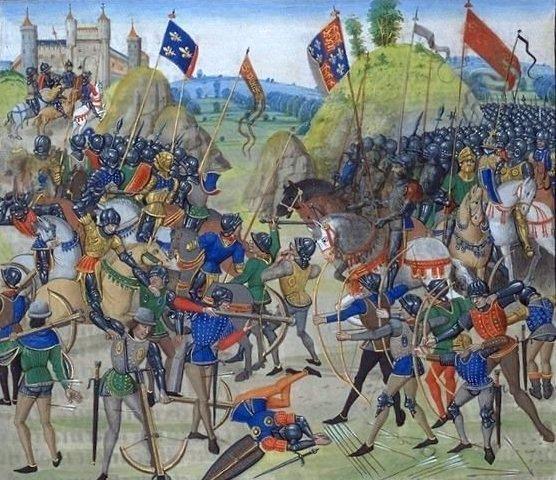The Battle of Dupplin Moor
The Battle of Dupplin Moor or 'Duplin Muir' took place on the
12th August 1332 and was the battle that began the Second Scottish
War of Independence fought between Edward Balliol and Donald of Mar
who had been appointed as Regent of Scotland only a few weeks
earlier.
The Background
The king of
Scotland Robert the Bruce died in 1329 and was succeeded by his four
year old son David. Edward Balliol, son of the former king John
Balliol, perceiving an opportunity now that Scotland's king was a
mere child began gathering support amongst the 'Disinherited', those
Scottish nobles who had lost their lands through their previous
opposition to Robert.
Whilst the Scots may well have been
expecting an assault, Edward Balliol simply decided to bypass the
Scottish defences and persuaded Edward III of England to provide a
fleet to transport his army across the North Sea. The expeditionary
force set off from the Humber and sailed round the Scottish defences
and landed at Kinghorn in Fife, where they were opposed by a small
force led by the earl of Fife, which was soon brushed aside. They
rapidly moved to take Dunfermline before continuing north across the
Ochil Hills on their way to Perth.
On the 11th August 1332
Balliol's army crossed the river Earn at a point some seven miles
southeast of the town of Perth and occupied the high ground on the
opposite bank to camp for the night. At dawn the next day they awoke
to find themselves facing a numerically superior Scots army eager to
come to battle and to prevent them from reaching Perth.
The Battle
The Scottish army under the
regent Donald of Mar was split into two divisions, most of whom were
carrying the traditional Scottish long spear. The English adopted
their by now customary tactics, where the men-at-arms all dismounted
and formed into lines to protect the ranks of Welsh mercenary
longbowmen, on loan from Edward III.
Since the Scots had the
advantage of numbers and naturally wished to drive the invading
force from Scottish soil, they attacked and charged Balliol's lines.
The Scots however failed to break through and were pressed back;
thus exposed on the field of battle they became targets for the
longbowmen and the Scots were hit by the volleys of arrows sent in
their direction.
The second Scottish division was then
ordered to attack and split into two columns and tried to outflank
Balliol's force. This second charge got nowhere near Balliol's lines
as they too were cut down by the volleys of arrows sent in their
direction.
Once the second charge had failed the Scots fell
back in disarray, their retreat being hampered as they stumbled
amongst the casualties already lying on the ground, making
themselves even easier targets for the enemy longbows. The battle
turned into a rout and according to one account the Scottish dead
were said to he piled fifteen feet high whilst the English
men-at-arms patiently waded through the battlefield finishing off
any Scot that showed any signs of life.
By the end of the
battle the Scottish dead included the earl of Mar himself, the earl
of Menteith and the earl of Moray, the High Chamberlain Alexander
Fraser, eighteen other Scottish barons and at least 2,000 soldiers
from the Scottish army. (Although estimates of the Scottish dead
vary wildly and as high as ten or thirteen thousand in some cases.)
The Aftermath
The battle of Dupplin Moor
followed the pattern set at the battle of Falkirk in 1298 and which
would be repeated again at Halidon Hill
and at Neville's Cross -
large numbers of Scottish infantry lined themselves up to fall in
their thousands to the firepower of the longbow. A clear
demonstration of the lesson that superior technology is capable of
overwhelming an enemy that fails to adjust its tactics.
So
Edward Balliol won the day and had himself crowned king of Scotland
at Scone, but his hold on the throne only lasted a few months as a
surprise attack on his camp forced him to flee 'half naked' back to
to England. The fruits of his victory at Dupplin Moor proved to be
shortlived.
The Second Scottish War of Independence was to
prove to be a drawn out affair; the young David II fled to France to
spend the next seven years in exile whilst Edward Balliol made
further attempts to take the crown that he believed was rightfully
his.
Errors and Omissions
|
|
The Forum
|
|
What's new?
|
|
We are looking for your help to improve the accuracy of The Douglas
Archives.
If you spot errors, or omissions, then
please do let us know
Contributions
Many articles are stubs which would benefit from re-writing.
Can you help?
Copyright
You are not authorized to add this page or any images from this page
to Ancestry.com (or its subsidiaries) or other fee-paying sites
without our express permission and then, if given, only by including
our copyright and a URL link to the web site.
|
|
If you have met a brick wall
with your research, then posting a notice in the Douglas Archives
Forum may be the answer. Or, it may help you find the answer!
You may also be able to help others answer their queries.
Visit the
Douglas Archives Forum.
2 Minute Survey
To provide feedback on the website, please take a couple of
minutes to complete our
survey.
|
|
We try to keep everyone up to date with new entries, via our
What's New section on the
home page.
We also use
the Community
Network to keep researchers abreast of developments in the
Douglas Archives.
Help with costs
Maintaining the three sections of the site has its costs. Any
contribution the defray them is very welcome
Donate
Newsletter
If you would like to receive a very occasional newsletter -
Sign up!
Temporarily withdrawn.
|
|
|
|
|
|
|
|


